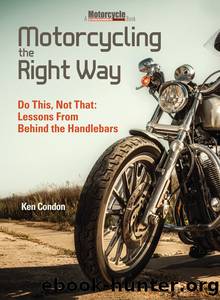Motorcycling the Right Way by Ken Condon

Author:Ken Condon [Condon, Ken]
Language: eng
Format: epub
Publisher: CompanionHouse Books
Published: 2015-09-21T04:00:00+00:00
FIGURE 8.2
Figure 8.2 illustrates the difference between a quick turn-in and a slow turn-in.
Cornering Lines
A cornering line is the path you take through a corner. A lot of riders simply ride down the middle of the road, echoing the shape of the curve. But remember, you have the option to ride in the left, center, or right portion of your lane, which offers several benefits not available to car drivers.
The basic cornering line is accomplished by entering the turn at the outside edge of the lane, turning toward the apex (the innermost part of the curve near the middle of the corner), and then exiting toward the outside of the lane. This âoutside-inside-outsideâ path straightens the corner radius, which uses less lean angle and keeps more traction in reserve in case you must increase lean angle or execute mid-corner braking or swerving maneuvers.
Entering a turn from the outside also allows a better angle of view into the curve to identify a cornerâs characteristics and any mid-corner hazards. Approaching from this location increases the likelihood that you will see problems early so you can adjust your entry speed if necessary.
Take a look at the âLesson Learnedâ box on this page to see how an imaginary rider struggles when he does not use cornering lines.
Corner Types
The ideal line varies depending on the type of corner you encounter. There are three basic types of corners: constant radius turns, increasing radius turns, and decreasing radius turns. Itâs important to be familiar with the different corner types so you can determine the best line to take for maximum traction and control.
â¢Constant radius turns resemble a section of a circle and are usually easy to negotiate because the turn maintains a constant arc from beginning to end. A constant radius turn calls for the most basic cornering line, one in which you enter from the outside of the turn, apex mid-corner, and exit wide (outside-inside-outside).
â¢Increasing radius turns begin with a smaller radius and end with a larger radius. You enter these turns slowly, where the turn is sharpest, and accelerate early as the corner straightens out. Follow the outside-inside-outside path as you would with a constant radius turn, but plan on turning in earlier and apexing sooner.
â¢Decreasing radius turns are the most dangerous type of corner because they tighten from the corner entry to the exit. On and off ramps are often decreasing radius turns, but these types of corners can be found anywhere. Many riders make the mistake of entering decreasing radius turns assuming the radius will remain constant. But this optimism can be deadly if they enter the corner too fast. A too-fast entry speed often results in a panicked rider responding poorly by locking the brakes or freezing at a lean angle that is insufficient to keep him or her from careening off the road. Decreasing radius turns are negotiated with the outside-inside-outside path, but it is important to turn in later so that the apex can be located further around the curve. This is referred to as a delayed apex cornering line.
Download
This site does not store any files on its server. We only index and link to content provided by other sites. Please contact the content providers to delete copyright contents if any and email us, we'll remove relevant links or contents immediately.
| History | Pictorial |
| Repair & Performance |
Machine Learning at Scale with H2O by Gregory Keys | David Whiting(4171)
Never by Ken Follett(3787)
Urban Outlaw by Magnus Walker(3338)
OPNsense Beginner to Professional by Julio Cesar Bueno de Camargo(3249)
Sapiens and Homo Deus by Yuval Noah Harari(2986)
Will by Will Smith(2790)
A Short History of Nearly Everything by Bryson Bill(2627)
Hooked: A Dark, Contemporary Romance (Never After Series) by Emily McIntire(2496)
Rationality by Steven Pinker(2290)
Borders by unknow(2227)
Holy Bible (NIV) by Zondervan(2086)
The Becoming by Nora Roberts(2085)
The One Percenter Encyclopedia by Bill Hayes(1787)
HBR's 10 Must Reads 2022 by Harvard Business Review(1776)
Freedom by Sonny Barger(1770)
A Short History of War by Jeremy Black(1758)
Five Ways to Fall by K.A. Tucker(1697)
Go Tell the Bees That I Am Gone by Diana Gabaldon(1685)
Girls Auto Clinic Glove Box Guide by Patrice Banks(1682)
